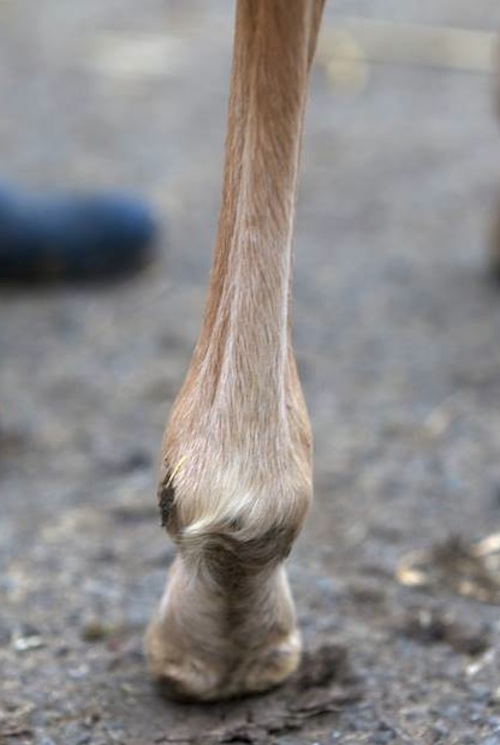Kevin Corley, BVM&S, PhD. DACVIM, DACVECC, DECEIM, MRCVS of the Anglesey Lodge Equine Hospital in County Kildare, Ireland shared photos of a recent case. A 12-hour-old Thoroughbred foal intended for future racing needed a treatment or management plan for an unusual hind limb deformity.
 |
The foal’s foot was flat on the ground, but the pastern was vertical and the fetlock knuckled forward.
|
Both the toe and heel of this unusually deformed hind foot are flat on the ground in the “before” photo. In most flexural deformity cases, toe or heel position would aid in diagnostics.
In flexural deformity cases, it helps to have the foal in front of you. A single photo or radiograph might not give enough information to evaluate the foal. Here is a photo of the same leg of the 12-hour- old Thoroughbred foal, from behind. Would this change your treatment plan at all?
The foal, viewed from behind, gives additional information that the foal also displayed a fetlock varus deformity.
 |
| This photo of the foal, viewed from behind, gives additional information that the left hind limb also displayed a fetlock varus deformity. |
The first step was to obtain radiographs of the limb. Notice how clearly you can see the growth plates in this foal’s fetlock and pastern.
 |
| Lateral radiograph of the foal in the first day of its life. Compare this to what you see in the photo. How would you describe what you see? |
Just as with the case photographs, the radiographs needed to show multiple views before a comprehensive diagnosis could be formulated.
 |
| A dorso-palmar radiograph of the same limb shows the fetlock varus deformity in the same limb. Compare this to the photo of the limb from behind. |
The diagnosis: superficial digital flexor (SDF) tendon contracture and deep digital flexor (DDF) tendon laxity. Normally, DDF tendon laxity would be easy to see; this is the common condition we call “weak pasterns” or "lax tendon" in newborn foals.
 |
| This is the same foal, now back on the farm, at three weeks of age. |
“I see a contracture like this one once every one to two years. I shared this case because it is relatively rare to have contraction of the SFT and laxity of the DDFT together.
“This was close to a subluxation of the coffin joint so we had to be quite careful in our approach.
“We cast the leg below the hock -- on for 12 hours and off for 12 hours -- for two days. The leg was gently pulled into the best possible position while the cast was setting.
 |
| Here is the same leg from behind, at the age of three weeks. The fetlock varus corrected with no additional treatment. |
“We placed the cast under diazepam/ketamine anaesthesia to relax the muscles and be able to hold the leg in the best possible position. We gave meloxicam as an analgesic at the time of casting. The cast was lightweight and went around the whole leg.
“We didn't give oxytetracycline because of laxity of the deep digital flexor.
“Costs are always a concern, but using a second new cast allowed us to extend the fetlock further than we had been able to with the first cast.
“This treatment arguably was the most cost efficient because it avoided prolonged treatment and even possible surgery. I think these cases with superficial digital flexor contracture and deep digital flexor laxity can be particularly challenging. “
About Kevin Corley
Kevin specializes in equine internal medicine and critical care, with particular interests in foal medicine, adult horse critical care, respiratory disease and cardiology. He is based at Anglesey Lodge Equine Hospital in Ireland, where he works mainly with Thoroughbreds and sport horses. He is available for consultations, second opinions and referral work both in Ireland and worldwide.Kevin is also a director of Veterinary Advances Ltd, a company producing high quality apps for veterinarians. They currently have 11 apps available including 'Foal CPR', an equine critical care app that Hoof Blog readers may download for free. This case is one of several that have been posted to the 'Equine Advances' Facebook page, which is run for the equine community by Veterinary Advances.
© Fran Jurga and Hoofcare Publishing; Fran Jurga's Hoof Blog is a between-issues news service for subscribers to Hoofcare and Lameness Journal. Please, no use without permission. You only need to ask. This blog may be read online at the blog page, checked via RSS feed, or received via a digest-type email (requires signup in box at top right of blog page). To subscribe to Hoofcare and Lameness (the journal), please visit the main site, www.hoofcare.com, where many educational products and media related to equine lameness and hoof science can be found. Questions or problems with this blog? Send email to blog@hoofcare.com.
Follow Hoofcare + Lameness on Twitter: @HoofcareJournal
Read this blog's headlines on the Hoofcare + Lameness Facebook Page




